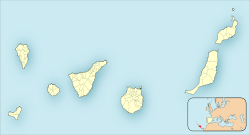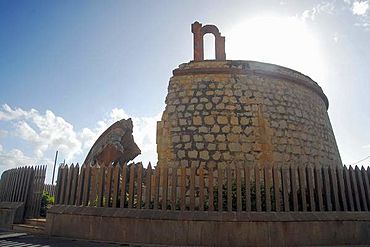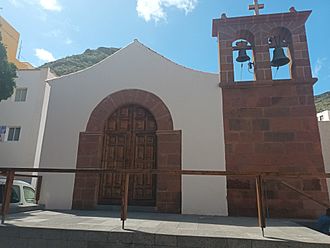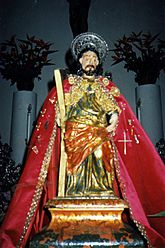San Andrés, Santa Cruz de Tenerife facts for kids
Quick facts for kids
San Andrés
|
||
|---|---|---|
|
Village
|
||
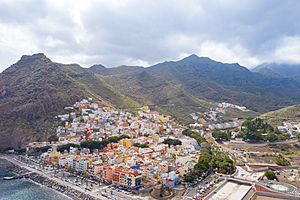
Drone view
|
||
|
||
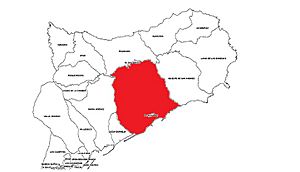
San Andrés within Santa Cruz de Tenerife
|
||
| Country | Spain | |
| Autonomous Community | Canary Islands | |
| Province | Tenerife | |
| Island | Tenerife | |
| Municipality | Santa Cruz de Tenerife | |
| Population
(2013)
|
||
| • Total | 3,121 | |
| Time zone | UTC+0 (CET) | |
| • Summer (DST) | UTC+1 (CEST (GMT +1)) | |
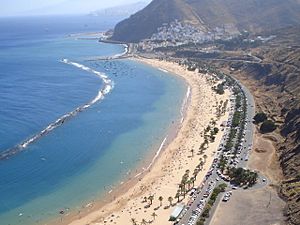
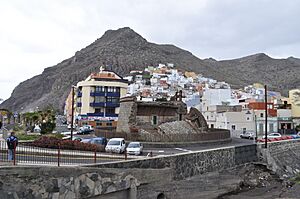
San Andrés is a charming village found on the beautiful island of Tenerife, which is part of the Canary Islands in Spain. It sits right on the coast, at the base of the Anaga mountains. The village is about 7 kilometers (4.3 miles) northeast of the capital city, Santa Cruz de Tenerife. It is managed as part of the municipality of Santa Cruz de Tenerife. San Andrés is one of the oldest villages in the Canary Islands, first settled around the year 1498.
Contents
What's in a Name?
San Andrés, which means 'Saint Andrew' in English, has had many names over time. The original inhabitants, the Guanches, called the two valleys that make up San Andrés "Abicor" and "Ibaute." Some people think "Abicor" was linked to fig trees.
After the Spanish arrived, the valley was known by names like "Higueras Valley" because of the many fig trees. It was also called "Salazar Valley" after the families who owned the land. Finally, the name San Andrés became the most common. This name honored Saint Andrew, a favorite saint of the Salazar family. In the early 1900s, it was also known as "San Andres de Pots" due to its pottery making.
A Look at San Andrés History
The area where San Andrés is located has been lived in for a very long time. The Guanches, who were the first people on Tenerife, lived here. Records from the time of the Canary Islands' conquest say that one of the caves where the aboriginal king of Anaga lived was in the San Andrés Valley. This king was named Beneharo.
An amazing discovery was made in a cave near San Andrés: the famous Mummy of San Andrés. This is a mummified body from the Guanche culture. Today, you can see it at the Museum of Nature and Man in Santa Cruz de Tenerife.
In 1498, a Spanish person named Lope de Salazar received these lands after the conquest. Between 1505 and 1510, Lope built a small chapel. This chapel was the start of the church you see today. He placed statues of St. Andrew and Saint Lucy inside. The Church of San Andrés was built on top of this older structure.
The Castle of San Andrés was also built in the village. Its main job was to protect Tenerife from pirates who often attacked the coast. Before the castle was built, the village was known as a "pirate port." This was because many pirate ships used the area as a place to land.
In 1797, San Andrés helped defend the island when Admiral Horatio Nelson attacked. Villagers joined the fight in Santa Cruz. The castle also helped stop the English from attacking this part of the coast.
During the 1800s, San Andrés was its own town. But in 1850, it became part of Santa Cruz de Tenerife.
Life in the village stayed mostly traditional through the first half of the 1900s. After the Spanish Civil War, the village faced difficult times.
In 1973, a big change happened. About 4 million bags of sand from the Sahara desert were brought to the island. This sand was used to improve the Las Teresitas beach. Since the 1960s, and especially in the 2000s, people have tried to make San Andrés a bigger tourist spot because of this famous beach.
Places to Visit
San Andrés has several interesting spots:
- The historic Castle of San Andrés
- The beautiful Church of St. Andrew the Apostle
- The famous Beach of Las Teresitas
- San Andrés's Maritime Avenue, great for walks by the sea
- The fishing dock, where you can see local boats
- The building of the town hall
- The Avenue Pedro Schwartz, also known as The Wall
- The cemetery, which is one of the oldest on the island
- The multicolor bridge, crossing the ravine at its mouth
Village Economy
Most people in San Andrés make their living from fishing. Tourism is also becoming a very important way for people to find jobs in the village.
Natural Surroundings
Not far from San Andrés, you'll find a beach called Playa de las Gaviotas. This beach is about 200 meters (656 feet) long and has black volcanic sand. It's near the village of Igueste de San Andrés.
In the nearby Macizo de Anaga mountains, there's an area called "El Bailadero." Old legends say this was a place where witches danced around bonfires and practiced magic.
See also
 In Spanish: San Andrés (Santa Cruz de Tenerife) para niños
In Spanish: San Andrés (Santa Cruz de Tenerife) para niños



